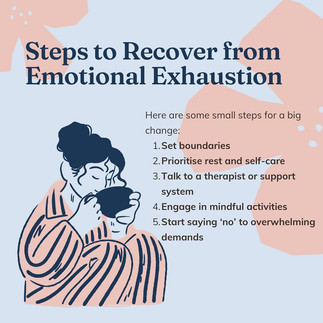In today’s fast-paced world, the concept of emotional exhaustion has gained significant attention, particularly as more individuals navigate the stresses of daily life, work, and personal relationships. Emotional exhaustion is not just a fleeting feeling of tiredness; it is a state of emotional fatigue that can deeply affect one's mental and physical well-being. In this article, we will explore the causes, symptoms, and effective strategies for managing emotional exhaustion, supported by research and expert insights.
What is Emotional Exhaustion?
Emotional exhaustion is characterized by a sense of depletion of emotional resources and energy, often resulting from prolonged stress or overwhelming emotional demands. It is frequently associated with burnout, a term that describes a syndrome involving physical, emotional, and mental exhaustion, typically due to chronic workplace stress (Maslach & Leiter, 2016). Emotional exhaustion can lead to various mental health issues, including anxiety and depression, making it crucial to address early on.
Causes of Emotional Exhaustion
Several factors contribute to emotional exhaustion, including:
Chronic Stress: Ongoing stress from work, personal relationships, or financial challenges can drain emotional reserves over time. Studies show that chronic stress activates the body’s fight-or-flight response, leading to increased cortisol levels, which can negatively impact mental health (Chrousos, 2009).
High Demands with Low Resources: In situations where individuals face high emotional demands without sufficient support or coping mechanisms, emotional exhaustion can occur. For instance, caregivers or professionals in high-stress occupations often experience this imbalance.
Lack of Control: Feeling powerless or lacking autonomy in one’s life can exacerbate feelings of exhaustion. When individuals perceive they have little control over their circumstances, they may experience heightened stress and fatigue (Sonnentag & Fritz, 2015).
Poor Work-Life Balance: Difficulty in maintaining a healthy separation between work and personal life can lead to emotional burnout. Research indicates that individuals who struggle to disconnect from work often report higher levels of emotional exhaustion (Frone, 2003).
Symptoms of Emotional Exhaustion
Emotional exhaustion can manifest in various ways, and recognizing these symptoms is essential for early intervention:
Chronic Fatigue: Persistent feelings of tiredness or low energy, even after adequate rest.
Cynicism and Detachment: A growing sense of negativity, irritability, or detachment from work and personal relationships.
Decreased Performance: Reduced productivity and difficulty concentrating or making decisions.
Physical Symptoms: Headaches, muscle tension, and gastrointestinal issues can accompany emotional exhaustion.
Strategies for Managing Emotional Exhaustion
Addressing emotional exhaustion involves a multifaceted approach, including self-care, professional support, and lifestyle changes:
Prioritize Self-Care: Engaging in regular self-care practices such as mindfulness, exercise, and adequate sleep can help restore emotional balance. Research shows that mindfulness practices, in particular, can reduce stress and improve emotional regulation (Keng, Smoski, & Robins, 2011).
Seek Support: Reaching out to friends, family, or mental health professionals can provide valuable emotional support. Social support has been shown to buffer against stress and reduce feelings of isolation (Cohen & Wills, 1985).
Set Boundaries: Learning to say no and setting clear boundaries between work and personal life can prevent overcommitment. This may involve delegating tasks or prioritizing essential activities to create a more manageable schedule.
Practice Stress Management Techniques: Incorporating relaxation techniques such as deep breathing, progressive muscle relaxation, or yoga can help alleviate stress and restore emotional well-being.
Engage in Meaningful Activities: Finding joy in hobbies, creative pursuits, or volunteering can enhance feelings of fulfillment and combat emotional exhaustion. Engaging in activities that align with personal values can provide a sense of purpose and connection.
Conclusion
Emotional exhaustion is a significant mental health concern that can impact individuals across various walks of life. By understanding its causes and symptoms, individuals can take proactive steps to manage and mitigate its effects. Prioritizing self-care, seeking support, and setting healthy boundaries are essential strategies for reclaiming emotional balance and well-being. If you or someone you know is struggling with emotional exhaustion, consider reaching out to a mental health professional for guidance and support.
Contact the mind practice or visit www.themindpractice.in for any mental health services.
References
Chrousos, G. P. (2009). Stress and disorders of the stress system. Nature Reviews Endocrinology, 5(7), 367-371. https://doi.org/10.1038/nrendo.2009.72
Cohen, S., & Wills, T. A. (1985). Stress, social support, and the buffering hypothesis. Psychological Bulletin, 98(2), 310-357. https://doi.org/10.1037/0033-2909.98.2.310
Frone, M. R. (2003). Work-family conflict: An overview of the theory, research, and future directions. *In K. Korabik, D. S. Lero, & D. L. Whitehead (Eds.), Handbook of work-family integration: Research, theory, and best practices (pp. 17-50). Academic Press.
Keng, S. L., Smoski, M. J., & Robins, C. J. (2011). Effects of mindfulness on psychological health: A review of empirical studies. Clinical Psychology Review, 31(6), 1041-1056. https://doi.org/10.1016/j.cpr.2011.04.006
Maslach, C., & Leiter, M. P. (2016). Burnout: A guide to identifying burnout and pathways to recovery. Harvard Business Review Press.
Sonnentag, S., & Fritz, C. (2015). Recovery from job stress: The stressor-recovery model. *In S. L. Albrecht (Ed.), The Sage handbook of organizational well-being (pp. 157-173). Sage Publications.













Comments